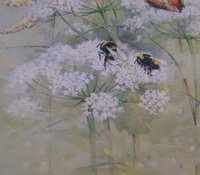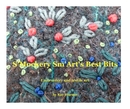You make a pattern like a row of equal sized 'beach huts' for the main part, and a pentagon with equal sides that measure the same as the bottom of a single 'beach hut'.
The box is made from a 'sandwich of top fabric, craft or pelmet vilene and felt.
I used a piece of hand dyed muslin for the top fabric and stitched all over it in a grid pattern to hold the layers together. The decorative 'tiles' were made on the embellisher and are patches of silk fabric overlayed onto dark green flannel. I bonded all the layers together to make it easier and that was a mistake on two counts: first, it makes it very stiff and quite difficult to work and secondly you lose the quilted look that you get when you machine onto felt. I managed to needle punch the tiles onto the thick fabric sandwich, (that machine has certainly got some punch!) but I wouldn't try to do it again because the machine did get a bit hot.
(click on photo for bigger image)
I straight stitched over the tiles in a spiral pattern to harmonise them a bit more with the main fabric and edged them with a machine wrapped cord. Then I edged the whole piece by machine zigzaging on some of the same cord around the edges and attached the base with ladder stitch. I wasn't really happy with what I had done, so I buttonholed all around the edges - much better!
Then I added cords with beads and a buttonholed curtain ring for the closure and stitched some pearly buttons onto the top tiles and Hey Presto! This is quite a quick method. It took me longer than it should have done because there was a lot of experimenting with the needle felted tiles and the buttonhole stitching took a while because the fabric was so stiff. If I used this method again I would put a piece of thin card in the base, because the vilene isn't firm enough.
Then I added cords with beads and a buttonholed curtain ring for the closure and stitched some pearly buttons onto the top tiles and Hey Presto! This is quite a quick method. It took me longer than it should have done because there was a lot of experimenting with the needle felted tiles and the buttonhole stitching took a while because the fabric was so stiff. If I used this method again I would put a piece of thin card in the base, because the vilene isn't firm enough.
I still prefer the 'old fashioned, traditional' method of covering and lining individual pieces of thick card and then ladder stitching them together but this is a quick, simple method with a minimum of hand stitching and no thick card to cut. There are very clear, easy to follow instructions and lots of good ideas for using this method in this book:





















